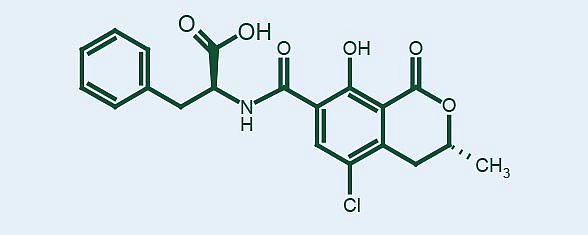What is Ochratoxin?

This mycotoxin is often referred to as ochratoxin A. Although ochratoxin B exists, it is of limited importance in diseases. Ochratoxin A is an innately fluorescent compound and detection during analysis is usually based on this property.
Production and occurrence
The primary producers of ochratoxin are Aspergillus ochraceus and Penicillium verrucosum. Other fungi such as Aspergillus niger and Aspergillus carbonarius may be important in some commodities or geographic areas.
Little is known of the conditions necessary for involvement of the producing fungi in grains and other commodities during development in the field. Therefore, ochratoxin has been regarded as being produced most likely in storage under conditions that would favor mold growth (adequate moisture/humidity and temperature).
Because of the diverse commodities on which the producing organisms and ochratoxin are found, the description of such is difficult. However, visible mold from the major species producing ochratoxin which vary from yellowish tan with A. ochraceus to blue-green with Penicillium species and black with A. niger or A. carbonarius. Visible mold may not be present for ochratoxin to occur in grains and other commodities. Grain that has a “musty” odor should be suspect for mycotoxins and ochratoxin would be included in the suspect list. Any time the integrity of the seed coat of grain has been compromised such as stress cracks and broken kernels, there is potential for invasion by the ochratoxin-producing fungi. Appropriate sampling for analysis is important as “hot spots” can occur in storage for the growth and ochratoxin production by these fungi.
As mentioned above, this is likely the major way that commodities become contaminated with ochratoxin. Grains stored under high moisture/humidity (>14%) at warm temperatures (>20°C) and/or inadequately dried potentially can become contaminated. Damage to the grain by mechanical means, physical means or insects can provide a portal of entry for the fungus. Initial growth of fungi in grains can form sufficient moisture from metabolism to allow for further growth and mycotoxin formation.
Toxicity
Ochratoxin is primarily a kidney toxin but if the concentration is sufficiently high there can be damage to the liver as well (Pfohl-Leszkowic and Manderville, 2007). Ochratoxin is a carcinogen in rats and mice and is suspect as the causative agent of a human disease, Balkan Endemic Nephropathy, that affects the kidneys and often tumors are associated with the disease (Wolstenholme et al., 1967). The toxin may be still present in products made from grain and the human population is exposed in this manner. A significant impact of ochratoxin is that it occurs in such a wide variety of commodities such as raisins, barley, soy products and coffee in amounts that may be relatively low. However, the levels may accumulate in the body of either humans or animals consuming contaminated food because ochratoxin is often not rapidly removed from the body and significant amounts may accumulate in the blood and other selected tissues. Ochratoxin produces necrosis of the proximal tubule epithelium and then is released whereby it is reabsorbed by albumin and continues to be circulated via the bloodstream. The awareness of the occurrence of ochratoxin in this wide variety of commodities has been possible through increased sensitivity of the methods for the analysis of ochratoxin. Of significance is the finding of high levels of ochratoxin in house dust (Richard et al., 1999) and could be an important entity in inhalation toxicology in humans and other animals as this compound apparently is absorbed efficiently by respiratory epithelium.
Published on:
Mycotoxin